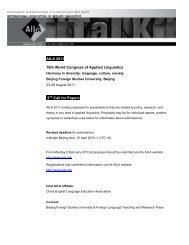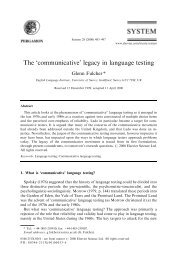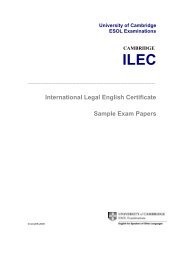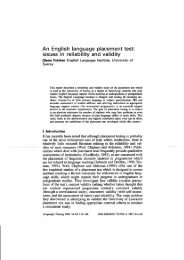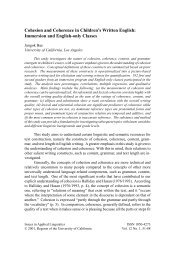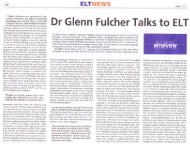Liaison Magazine - LLAS Centre for Languages, Linguistics and ...
Liaison Magazine - LLAS Centre for Languages, Linguistics and ...
Liaison Magazine - LLAS Centre for Languages, Linguistics and ...
Create successful ePaper yourself
Turn your PDF publications into a flip-book with our unique Google optimized e-Paper software.
eview<br />
Japan’s Built-in Lexicon of<br />
English-based Loanwords<br />
Review by Tessa Carroll<br />
In his new book, Frank Daulton makes<br />
the case that the vast numbers of<br />
English-based loanwords in Japanese<br />
constitute a largely ignored <strong>and</strong><br />
untapped resource <strong>for</strong> Japanese learners<br />
of English.This is an attractive argument,<br />
since the difficulties <strong>for</strong> Japanese<br />
speakers learning English – <strong>and</strong> vice<br />
versa – stem largely from the fact that<br />
the two languages are completely<br />
unrelated in grammar <strong>and</strong> lexicon.<br />
However, the flood of English words that<br />
has entered Japanese since the late<br />
nineteenth century, <strong>and</strong> particularly since<br />
World War II, is potentially helpful to the<br />
learner, just as recognising that door is<br />
related to Tür helps Germans learning<br />
English. But, whereas the role of<br />
cognates in language learning between<br />
European languages is widely recognised,<br />
in Japan, there has been resistance to<br />
exploit English-based loanwords in this<br />
way, <strong>for</strong> reasons discussed <strong>and</strong>, to a great<br />
extent, refuted by Daulton.<br />
The book is divided into four parts:<br />
Japan’s importation of English; gairaigo<br />
(loanwords, literally “words coming from<br />
abroad”) <strong>and</strong> language acquisition; the<br />
built-in lexicons; <strong>and</strong> exploiting Japanese<br />
loanword cognates. An epilogue offers<br />
more prospects <strong>and</strong> suggestions <strong>for</strong> the<br />
application of the author’s findings in<br />
teaching. Around 40 pages of appendices<br />
demonstrate the overlap between<br />
loanwords in Japanese <strong>and</strong> the most<br />
commonly used English words taken<br />
from the British National Corpus <strong>and</strong><br />
academic words (Coxhead 1998).<br />
Although the book is aimed mainly at<br />
English as a Foreign Language (EFL)<br />
teachers <strong>and</strong> Second Language<br />
Acquisition (SLA) researchers, the first<br />
part will also be of interest to teachers<br />
<strong>and</strong> learners of Japanese. Chapter 1<br />
provides a succinct introduction to the<br />
Japanese language <strong>and</strong> writing system,<br />
<strong>and</strong> to EFL <strong>and</strong> the English language in<br />
Japan, followed by an excellent historical<br />
<strong>and</strong> linguistic overview of the<br />
complexities of how English words have<br />
been adopted <strong>and</strong> adapted by Japanese<br />
speakers. Daulton has spent nearly<br />
twenty years teaching English in Japan,<br />
<strong>and</strong> his description is depressingly<br />
familiar to my own experience of<br />
teaching in Japanese state schools in the<br />
early 1980s, since when little seems to<br />
have changed:“Japanese EFL is<br />
characterized by not only its<br />
dependence on grammar-translation <strong>and</strong><br />
focusonentranceexams,butbylarge<br />
classes of taciturn students.” (p.2)<br />
The bulk of the book examines the<br />
role of cognates in language learning,<br />
focusing particularly on the author’s<br />
long-term research into Japanese<br />
students’ underst<strong>and</strong>ing <strong>and</strong> use of<br />
loanword cognates. Supporting the<br />
argument that errors play an important<br />
developmental role in learners’<br />
interlanguage, Daulton makes the<br />
important point that “[t]he advantage of<br />
errors over avoidance is especially stark<br />
in the context of Japanese EFL learners”,<br />
who tend to be passive <strong>and</strong> reticent to<br />
communicate. He goes on to examine in<br />
detail common loanword cognates <strong>for</strong><br />
high-frequency <strong>and</strong> academic English<br />
vocabulary, <strong>and</strong> quantifies the extent to<br />
which they overlap semantically <strong>and</strong><br />
<strong>for</strong>mally. Daulton notes his astonishment,<br />
shared by this reviewer, at the number of<br />
high-frequency cognates:“around half of<br />
high-frequency [English] word families<br />
Frank E. Daulton<br />
(2008)<br />
Clevedon: Multilingual Matters<br />
ISBN: 978-1-84769-030-2<br />
<strong>Liaison</strong> magazine • llas.ac.uk •41



